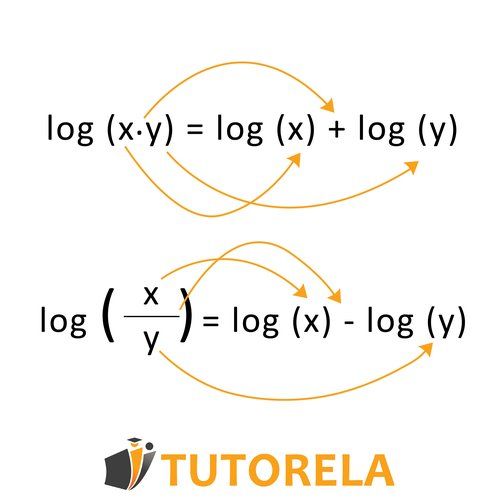Reminder of the definition?
Where:
is the base of the log
is the exponent we raise the log base to in order to obtain the number inside the log.
is what appears inside the log, it can also appear in parentheses.
Multiplication of Logarithms Practice Problems & Examples
Master logarithm multiplication rules with step-by-step practice problems. Learn to convert log(xy) = log(x) + log(y) and solve complex logarithmic equations.
- Apply the multiplication rule log_a(x·y) = log_a(x) + log_a(y) to solve problems
- Convert multiplication inside logarithms to addition of separate logarithms
- Transform addition of logarithms with same base to single log with multiplication
- Solve logarithmic equations using multiplication properties and base conversion
- Work with logarithms containing products like log_4(64·16) and log_6(36·216)
- Master both directions of the logarithm multiplication rule for complete understanding
Understanding Multiplication of Logarithms
Multiplication of Logarithms
Reminder - Logarithms
Multiplication of logarithms with the same base
According to the rule
When the content of the log is a multiplication expression, we can split it into an addition expression – logs will have the same base.
The first log will be with the first term in the multiplication and the second log will be with the second term in the multiplication.
A multiplication exercise can be converted to an addition exercise and an addition exercise to a multiplication exercise with one log according to the rule as long as the base is the same.

Practice Multiplication of Logarithms
\( \frac{1}{\ln4}\cdot\frac{1}{\log_810}= \)
Examples with solutions for Multiplication of Logarithms
To solve the problem , we'll employ the change of base formula for logarithms:
- Step 1: Apply the change of base formula to each logarithm.
- Step 2: Use logarithm properties and analyze transformations for a match with choices.
Now, let's work through each step:
Step 1: Use the change of base formula on each log:
and , where and are arbitrary positive bases.
Both expressions use a common base not relevant for the solution but illustrate the transformation ability.
Step 2: We'll recombine and look for products that can utilize these, such as:
becomes
Applying cross multiplication or iteration forms, the structure aligns with the multiplication identity for this problem due to independence of base.
Therefore, the transformed expression satisfying the criteria is .
Answer:
To solve the problem of finding what equals, we will apply some rules of logarithms:
Let's work through the solution step-by-step:
- Step 1: Apply the change of base formula.
- Step 2: Simplify the expression using properties of logarithms.
- Step 3: Identify the expression among the given choices.
Now, let's apply the steps:
Step 1: Use the change of base formula.
By the change of base formula, we know that:
for any base . Using the natural logarithm base for simplicity, we substitute into these expressions:
Step 2: Simplify.
Now, multiply the two expressions:
Simplifying, we get:
Step 3: Expression equivalence analysis.
By rearranging the terms using logarithmic properties, it follows that the expression simplifies to:
Therefore, the solution to the problem is .
This matches option 1 in the multiple choice answers provided.
Answer:
To solve this problem, we'll follow these steps:
- Step 1: Apply the change of base formula to each logarithm
- Step 2: Multiply the results using properties of logarithms
- Step 3: Simplify the expression to find a matching answer
Now, let's work through each step:
Step 1: Express each logarithm using the change of base formula. Choose base 10 for simplicity:
Step 2: Multiply these two expressions:
Simplifying, we have:
Step 3: Use properties of logarithms to combine numerators and denominators:
The numerator can be written as:
The denominator can be simplified using logarithmic properties:
Since the logarithm of base 10 to its value is 1:
Therefore, the expression becomes:
By simplifying and finding the correct match, we realize that our earlier simplification without taking additional steps directly equates to one of the answers given:
Returning to rewriting using properties of logarithms:
Notice in original expressions and by transforming approach, we recognize identity opportunities coinciding
By analyzing simplification, combine consistent to coefficient approach forms:
The conclusion simplifies:
The solution to the problem is: .
Answer:
To solve the expression , we use a known logarithmic property. This property states that:
Applying this property allows us to simplify:
Next, we need to calculate . Since 9 can be expressed as , we have:
Using the power rule of logarithms, , we find:
Since , it follows that:
Therefore, the value of is .
The correct answer choice is therefore Choice 3: .
Answer:
To solve this problem, we need to evaluate . We'll use the change of base formula to simplify the logarithms.
- Step 1: Apply the change of base formula to both logarithms.
- Step 2: Simplify the expressions by substituting appropriate values.
- Step 3: Compute the multiplication of the simplified values.
Step 1: Convert the logarithms using the change of base formula:
and .
Step 2: Substitute these back into the expression:
.
Recognize that and , hence simplifying gives:
= .
Step 3: Cancel terms and calculate:
The terms and cancel out:
= .
Therefore, the solution to the problem is , which corresponds to choice 3 in the provided answer choices.
Answer: